
Eucalyptus marginata, commonly known as jarrah, djarraly in Noongar language and historically as Swan River mahogany, is a plant in the myrtle family, Myrtaceae and is endemic to the south-west of Western Australia. It is a tree with rough, fibrous bark, leaves with a distinct midvein, white flowers and relatively large, more or less spherical fruit. Its hard, dense timber is insect resistant although the tree is susceptible to dieback. The timber has been utilised for cabinet-making, flooring and railway sleepers.

Forage is a plant material eaten by grazing livestock. Historically, the term forage has meant only plants eaten by the animals directly as pasture, crop residue, or immature cereal crops, but it is also used more loosely to include similar plants cut for fodder and carried to the animals, especially as hay or silage.
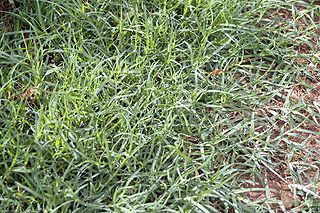
Cynodon dactylon, commonly known as Bermuda grass, is a grass found worldwide. It is native to Europe, Africa, Australia and much of Asia. It has been introduced to the Americas. Contrary to its common name, it is not native to Bermuda and is in fact an abundant invasive species there. In Bermuda it has been known as "crab grass". Other names are Dhoob, dūrvā grass, ethana grass, dubo, dog grass, dog's tooth grass, Bahama grass, crab grass, devil's grass, couch grass, Indian doab, arugampul, grama, wiregrass and scutch grass.
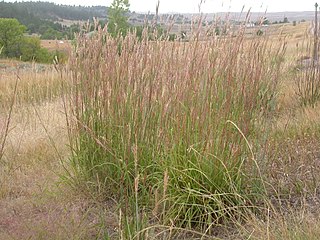
Andropogon gerardi, commonly known as big bluestem, is a species of tall grass native to much of the Great Plains and grassland regions of central and eastern North America. It is also known as tall bluestem, bluejoint, and turkeyfoot.
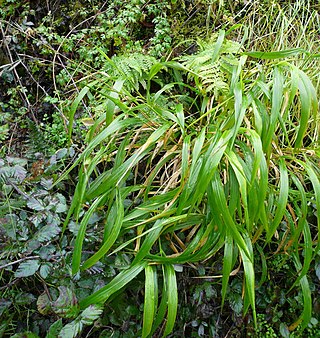
Brachypodium sylvaticum, commonly known as false-brome, slender false brome or wood false brome, is a perennial grass native to Europe, Asia and Africa. It has a broad native range stretching from North Africa to Eurasia.

Banksia marginata, commonly known as the silver banksia, is a species of tree or woody shrub in the plant genus Banksia found throughout much of southeastern Australia. It ranges from the Eyre Peninsula in South Australia to north of Armidale, New South Wales, and across Tasmania and the islands of Bass Strait. It grows in various habitats, including Eucalyptus forest, scrub, heathland and moorland. Banksia marginata varies widely in habit, ranging from a 20-centimetre (7.9 in) shrub to a 12-metre (40 ft) tree. The narrow leaves are linear and the yellow inflorescences occur from late summer to early winter. The flower spikes fade to brown and then grey and develop woody follicles bearing the winged seeds. Originally described by Antonio José Cavanilles in 1800, further collections of B. marginata were designated as several separate species by Robert Brown in 1810. However, all were reclassified as a single species by George Bentham in 1870. No distinct subspecies have been recognised by Banksia expert Alex George, who nonetheless concedes that further work is needed.
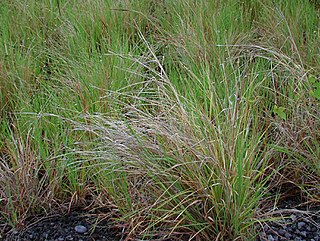
Heteropogon contortus is a tropical, perennial tussock grass with a native distribution encompassing Southern Africa, southern Asia, Northern Australia, Oceania, and southwestern North America. The species has also become a naturalised weed in tropical and subtropical regions in the Americas and East Asia. The plant grows to 1.5 metres (4.9 ft) in height and is favoured in most environments by frequent burning. The plants develop characteristic dark seeds with a single long awn at one end and a sharp spike at the other. The awn becomes twisted when dry and straightens when moistened, and in combination with the spike is capable of drilling the seed into the soil.

Arrhenatherum elatius, with the common names bulbous oat grass, false oat-grass, tall oat-grass, tall meadow oat, onion couch and tuber oat-grass, is a species of perennial grass, native to Europe, western Asia, and northern Africa.

Hyparrhenia hirta is a species of grass known by the common names common thatching grass and Coolatai grass. It is native to much of Africa and Eurasia, and it is known on other continents as an introduced species. In eastern Australia it is a tenacious noxious weed. In South Africa, where it is native, it is very common and one of the most widely used thatching grasses. It is also used for grazing livestock and weaving mats and baskets.

Leymus cinereus is a species of wild rye known by the common names basin wild rye, Great Basin wild rye, and Great Basin lyme grass.
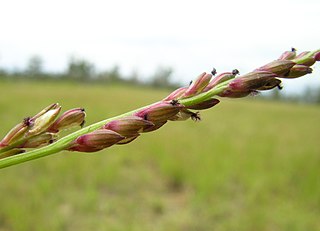
Entolasia is a genus of African, Australian, and Papuasian plants in the grass family.

The Manitoba Tall Grass Prairie Preserve is located in southeastern Manitoba near Gardenton and Vita, this is about 50 kilometres (31 mi) south of Steinbach, Manitoba. It is one of the last remaining stands of tallgrass prairie in Manitoba and is part of the Tallgrass Aspen Parkland conservation area in Manitoba and Minnesota. Several groups and organizations help in land preservation in the Manitoba Tall Grass Prairie such as the Nature Conservancy of Canada, Nature Manitoba, Environment Canada, Manitoba Conservation and the Manitoba Habitat Heritage Corporation.
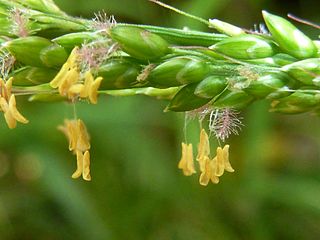
Setaria megaphylla, the broad-leaved bristle grass, big-leaf bristle grass, ribbon bristle grass, or bigleaf bristlegrass, is native to south-eastern Africa. It is also cultivated, and it has naturalized outside its native range, for example, in Florida in the United States.

Trisetum flavescens, the yellow oatgrass or golden oat grass, is a species of grass in the family Poaceae. It is native to Europe, Asia, and North Africa.

Watsonia marginata is a species of flowering plant in the family Iridaceae known by the common name fragrant bugle-lily. It is native to the Cape Provinces of South Africa, but it is well known as an ornamental plant grown in gardens for its showy spikes of flowers. Its native range is an area with winter rainfall and dry summers. It is a perennial herb growing from a corm and growing to a maximum height well over one metre when in flower, sometimes reaching two metres. Each corm produces three or four erect leaves that measure up to 80 cm long by 5 wide. They are blue-green with thickened yellow margins. The inflorescence is a dense spike of 30 to 50 flowers which may be any shade of pink or sometimes dark red or white. The flower is actinomorphic, or radially symmetrical, unlike those of other Watsonia, which are zygomorphic. The flowers are several cm long.

Desmostachya bipinnata, commonly known as halfa grass, big cordgrass, and salt reed-grass, is an Old World perennial grass, long known and used in human history. The grass is tall, tufted, leafy, perennial grass, branching from the base, erect from a stout creeping rootstock.

Entolasia stricta, commonly known as wiry panic, is a species of right angled grass in the family Poaceae. It is found in eastern Australia on sandy or sandstone-based soils. The leaves are inrolled or curved inwards and somewhat rough to the touch. It first appeared in scientific literature in 1810 as Panicum strictum in the Prodromus Florae Novae Hollandiae, authored by the prolific Scottish botanist Robert Brown. It was given its current name in 1923.

Nassella leucotricha is a species of grass known by the common names Texas wintergrass, Texas needlegrass, and Texas tussockgrass. It is native to the south-central United States and much of Mexico.

Western Sydney Regional Park is a large urban park and a nature reserve situated in Western Sydney, Australia within the suburbs of Horsley Park and Abbotsbury. A precinct of Western Sydney Parklands, a park system, and situated within the heart of the Cumberland Plain Woodland, the regional park features several picnic areas, recreational facilities, equestrian trails, and walking paths within the Australian bush.

The Shale Sandstone Transition Forest, also known as Cumberland Shale-Sandstone Ironbark Forest, is a transitory ecotone between the grassy woodlands of the Cumberland Plain Woodlands and the dry sclerophyll forests of the sandstone plateaus on the edges of the Cumberland Plain in Sydney, Australia.




















